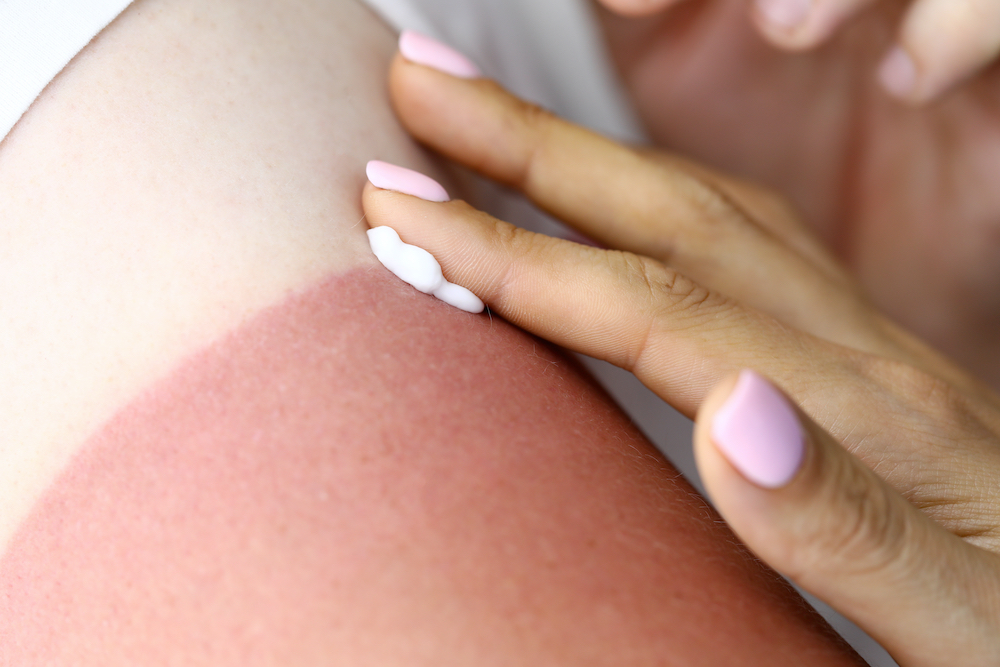The Dos and Don’ts of How to Treat a Sunburn

This summer is scorching, and even those of us who are well-intentioned and apply sunscreen can find themselves dealing with signs of sunburn in areas we missed, or by being more exposed than we anticipated. To stay cool, spending time near water can be tempting, but it intensifies the sun’s rays as they reflect off the water. So, the reality is that you may likely have to treat a sunburn this summer. When it comes to caring for a sunburn, certain dos and don’ts should be followed to help alleviate any pain and discomfort and aid the skin in healing. Most sunburns are considered first-degree burns, which affect only the outer layer of the skin. However, more severe sunburn can penetrate deeper and cause more damage, which is considered a second-degree burn. Treatments vary depending on the type of burn, but leaving a sunburn untreated can prolong the healing process.
Severe Sunburns
Blisters are indicative of a second-degree sunburn, and depending on the severity of the symptoms, may require a visit to a medical professional. Any signs of nausea, fatigue, or dizziness may be complicated by severe dehydration. Blistered skin that has broken risks infection and can leave permanent scarring. Some patients experience permanent skin discoloration in the areas where the blisters formed. Skin cancer risk is significantly increased with each sunburn, and when an individual has more than five second-degree sunburns, they are between 60-80% more at risk of getting some form of skin cancer.
The Dos of Sunburn Care
A day in the sun can quickly become a painful sunburn, and some treatments can be easily done at home for mild burns. Identifying a sunburn quickly can help when treatment begins sooner rather than later. Although not all home remedies are recommended, some are safe for most people and can be done promptly and expedite healing. Using room-temperature water or cooler water can help alleviate some of the discomfort and pain associated with sunburn. Using mild liquid soap without perfumes keeps skin clean, and lotion can be applied, but it should not have perfumes or dyes. Some of the most popular known for sunburn treatments are Aquaphor and Aveeno. Lotion can be placed in the refrigerator to add an extra level of cooling to the skin, if time allows.
Beyond topical treatments, over-the-counter ibuprofen can help reduce inflammation and pain; however, it should not be taken if there are health concerns associated with using the medication. Any severe symptoms or skin that appears to be delayed in healing, becoming infected, or discoloring should be evaluated by a professional. Dermatologists can assess and treat sunburns, helping patients understand how to care for their skin as it heals and recovers. Peeling skin must also be cared for, so skin does not open up to infection and germs.
The Don’ts of Sunburn Care
The most surprising thing about sunburn treatment is not to apply ice. Ice can cause frostbite, and dealing with frostbitten, sunburned skin is even worse. Sunburned skin needs to heal and rest, not be injured further by the misapplication of ice. Cool compresses are fine, but sometimes skin is too burned, and this can cause discomfort. Contrary to what some people claim, using household items like honey or ketchup will not help the skin. Stay away from anything with alcohol in it, especially those aloe products that contain it – it can sting and burn.
If you are unable to see a dermatologist or skincare specialist after your burn, it is not a good idea to use antibiotic creams without a medical professional’s prescription. Using someone else’s medications can cause further irritation, worsen the burn, and delay healing. Most importantly, DO NOT go back in the sun with a sunburn! As skin heals, it needs a break from any sun exposure. So, if you get a burn on your first day of summer camp on the lake, plan to wear a long-sleeved shirt when spending time outdoors. There are comfortable sun-protective wear that can be worn as a layer to protect against the sun’s harmful rays. Always wear sunscreen, a hat, and glasses when outside.
Preventive Sunburn Care
Sunburns aren’t what they used to be. Repeatedly exposing one’s skin to the sun’s harmful rays and leaving severe second-degree sunburns untreated can result in permanent physical scars on the skin. Use preventive measures every day, and when anticipating prolonged sun exposure, plan by bringing a supply of shade relief, sun protection gear, and topical products to ensure sun safety.
If you have concerns about a sunburn as it heals or want to schedule a skin cancer screening, contact Buckhead Dermatology in Atlanta today to book an appointment.
